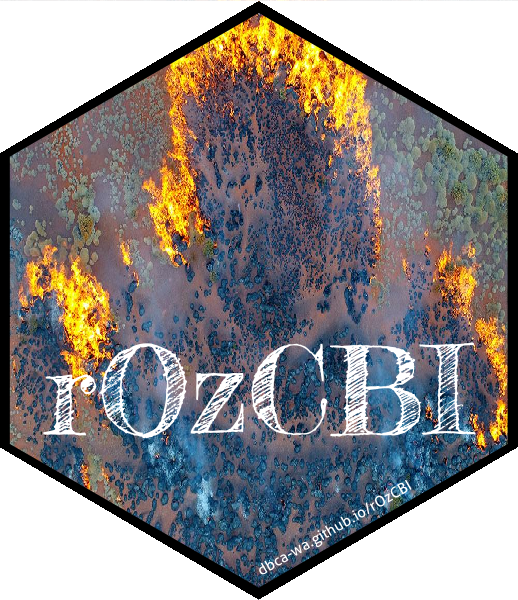rOzCBI in a nutshell:
- OpenDataKit forms to evaluate a burnt site.
- Helpers to calculate the OzCBI from the burn grading field data for both forest and heath communities.
- Instructions to get up and running with data capture and data analysis.
- Working examples of the entire data flow.
What
To evaluate the severity of burns, the differential normalised burn ratio (dNBR) of a burnt site can be derived from satellite imagery cost-effectively and on a large scale. The NBR is calculated from NIR and SWIR bands as NBR = (NIR−SWIR)/(NIR+SWIR). The dNBR is calculated from pre- and post-burn NBR as dNBR = NBRpost/NBRpre. To calibrate the dNBR, ground truthing field work can derive an index called “OzCBI” from the condition and composition of a burnt site.
rOzCBI contains background, digital data capture, analysis, and visualisation for the calculation of OzCBI, a composite burn index for the initial assessment of the short-term burn severity from remotely sensed data.
OzCBI was derived from GeoCBI, which was first described in De Santis, Angela & Chuvieco, Emilio. (2009) (Fulltext (pdf)) GeoCBI: A modified version of the Composite Burn Index for the initial assessment of the short-term burn severity from remotely sensed data. Remote Sensing of Environment 113
DOI 10.1016/j.rse.2008.10.011
OzCBI was further modified to suit Australian vegetation communities by Valerie Densmore at DBCA in Western Australia. This version of the OzCBI is currently being tested and validated so the current version may not reflect the final form. Feedback on the use and validity of OzCBI is welcome as GitHub issues.
OzCBI has been published as
V. S. Densmore, R. J. van Dongen, R. Ong & B. G. Harris (2023) OzCBI: the composite burn index adapted to assess fire severity and key fauna habitat features in Australian ecosystems, Australian Forestry, 86:1, 1-21, DOI: 10.1080/00049158.2023.2168400
How
rOzCBI supplies an Xform to capture data digitally using OpenDataKit, then goes on to access the data directly from R using the package ruODK, and provides helper methods to calculate the OzCBI from the captured data.
You can install the development version from GitHub with:
# install.packages("devtools")
remotes::install_github("dbca-wa/rOzCBI")The overall data flow from digital form to data analysis is described at ruODK.

Read vignette Digital Data Capture on the design and setup of the digital data capture form and infrastructure.
Read vignette Data analysis on access, analysis, and visualisation of the captured burn grading data using the GeoCBI assessment method.
Windows users might see the curl error unable to get local issuer certificate when using an ODK Central instance with self-signed SSL certificates. This can be fixed (source) through the following line:
library(httr)
httr::set_config(httr::config(ssl_verifypeer = FALSE))As it decreases security, it is recommended to only run this when necessary.
Who
The methodology was compiled and adapted to Western Australian vegetation by Valerie Densmore (DBCA).
The R package rOzCBI was developed, and is maintained, by Florian Mayer for the Western Australian Department of Biodiversity, Conservation and Attractions (DBCA).
The background image in the package logo shows the aerial view of a prescribed burn in the Pilbara. Photo: Paul Rampant (DBCA).
To cite package rOzCBI in publications use:
citation("rOzCBI")
#> To cite rOzCBI in publications use:
#>
#> Valerie Densmore, Florian W. Mayer (2020). rOzCBI: A Burn Severity
#> Assessment Toolkit for Austral Vegetation Communities. R package
#> version x.x.x. https://github.com/dbca-wa/rOzCBI
#>
#> A BibTeX entry for LaTeX users is
#>
#> @Misc{,
#> title = {rOzCBI: A Burn Severity Assessment Toolkit for Austral Vegetation Communities},
#> author = {Valerie Densmore and Florian W. Mayer},
#> note = {R package version x.x.x},
#> year = {2020},
#> url = {https://github.com/dbca-wa/rOzCBI},
#> }Contribute
Feedback and bug reports are welcome as issues.
The package development workflow is described in vignette Development.



